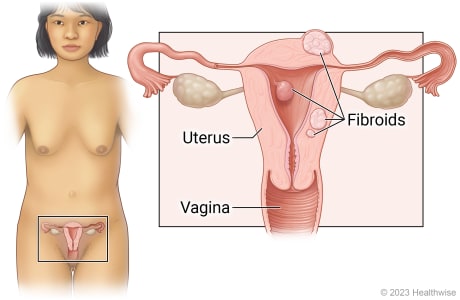Uterine Fibroid Embolization: Before Your Procedure

What is uterine fibroid embolization?
Uterine fibroid embolization is a treatment to destroy or shrink fibroids. Fibroids are growths on the outer wall, on the inner wall, or inside the wall of the uterus. Sometimes they're called fibroid tumours, but they aren't cancer.
You may be awake during the procedure. But you will get medicine to help with pain. And you may be given medicine to help you relax. First the doctor will put a thin, flexible tube into a blood vessel in the upper thigh. The tube is called a catheter. Then the doctor sends a solution through the catheter. It prevents your fibroids from getting blood. Without blood, the fibroids shrink or die.
The treatment usually takes 1 to 3 hours. After the procedure, you may stay in the hospital overnight or go home the same day.
You may have some pain for a few hours to a few days. But sometimes pain can last for a couple of weeks. It may take about 1 to 2 weeks to fully recover.
This treatment should reduce pain and bleeding from fibroids.
How do you prepare for the procedure?
Procedures can be stressful. This information will help you understand what you can expect. And it will help you safely prepare for your procedure.
 Preparing for the procedure
Preparing for the procedure
- Do not eat or drink for 6 to 8 hours before the procedure.
- Be sure you have someone to take you home. Some medicines you'll get during the procedure will make it unsafe for you to drive or get home on your own.
- Understand exactly what procedure is planned, along with the risks, benefits, and other options.
- If you take aspirin or some other blood thinner, ask your doctor if you should stop taking it before your procedure. Make sure that you understand exactly what your doctor wants you to do. These medicines increase the risk of bleeding.
- Tell your doctor all the medicines and natural health products you take. Some may increase the risk of problems during your procedure. Your doctor will tell you if you should stop taking any of them before the procedure and how soon to do it.
- Make sure your doctor and the hospital have a copy of your advance care plan. If you don't have one, you may want to prepare one. It lets others know your health care wishes. It's a good thing to have before any type of surgery or procedure.
- You may be asked to have blood tests done before your procedure.
What happens on the day of the procedure?
Follow the instructions exactly about when to stop eating and drinking. If you don't, your procedure may be cancelled. If your doctor told you to take your medicines on the day of the procedure, take them with only a sip of water.
Take a bath or shower before you come in for your procedure. Do not apply lotions, perfumes, deodorants, or nail polish.
Take off all jewellery and piercings. And take out contact lenses, if you wear them.
At the hospital
Bring a picture ID and your Alberta Personal Health Care card.
You will be kept comfortable and safe by your healthcare team. You may get medicine that relaxes you or puts you in a light sleep. The area being worked on will be numb.
The procedure will take about 1 to 3 hours.
After the procedure, pressure will be applied to the area where the catheter was put in your blood vessel. Then the area may be covered with a bandage or a compression device. This will prevent bleeding.
Nurses will check your heart rate and blood pressure. The nurse will also check the puncture site for bleeding.
If the catheter was put in your groin, you will need to lie still and keep your leg straight for several hours.
If the catheter was put in your arm, you may be able to sit up and get out of bed right away. But you will need to keep your arm still for at least 1 hour. Check with your healthcare team before getting up.
You may have a bruise or a small lump where the catheter was put in your blood vessel. This is normal and will go away.
You may also have post-embolization syndrome (PES). This is a common side effect following this procedure. Symptoms can include:
- Pain and cramping.
- Low-grade fever.
- Nausea, vomiting, or both.
- Feeling unwell.
Symptoms typically start within a few days of the embolization and may last anywhere from 2 to 3 days or up to 2 weeks. These symptoms will go away by themselves.
Your doctor may prescribe medicine to manage your symptoms, such as pain or anti-nausea medicine. If you are not taking prescription medicine, ask your doctor if you can take an over-the-counter medicine such as Tylenol or Gravol.
When should you call your doctor?
- You have questions or concerns.
- You don't understand how to prepare for your procedure.
- You become ill before the procedure (such as fever, flu, or a cold).
- You need to reschedule or have changed your mind about having the procedure.
Where can you learn more?
Go to https://www.healthwise.net/patientEd
Enter C717 in the search box to learn more about "Uterine Fibroid Embolization: Before Your Procedure".
Adaptation Date: 04/28/2022
Adapted By: Alberta Health Services
Adaptation Reviewed By: Alberta Health Services
